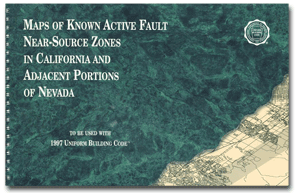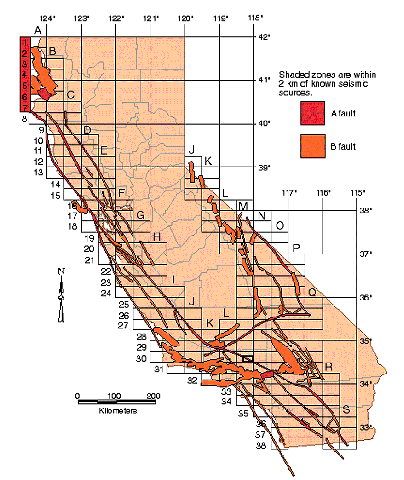 from
Seismic Hazard Mapping Bulletin #7, released on April 15, 1998.
from
Seismic Hazard Mapping Bulletin #7, released on April 15, 1998.
Maps of Known Active Fault Near-Source Zones in California and Adjacent Portions of Nevadawas prepared by the California Geological Survey (CGS) in cooperation with the Structural Engineers Association of California’s (SEAOC) Seismology Committee, and was published by the International Conference of Building Officials.
The near-source maps, developed specifically for use with the 1997 Uniform Building Code™ (UBC), define the areas where an additional factor should be used to reduce risk to life and property in an earthquake. The 1997 UBC incorporated a new factor in engineering calculations to account for high ground motion near earthquake faults.
The near-source maps are based on research following the Northridge and Kobe, Japan earthquakes showing that most buildings collapsing or having severe damage are located within five kilometers (three miles) of fault rupture. As a result of their observations, seismologists and engineers now recommend additional reinforcement of buildings located within a few kilometers of historical ground ruptures.
Determination of the near-source factor requires extensive geologic and seismologic information. First, a fault must be evaluated to determine whether it is active. Geologists generally consider a fault active if surface ground rupture has occurred during the last 11,000 years.
Second, the fault must be located on a three-dimensional grid. This information is available on the CGS Fault Activity Map of California and Adjacent Areas, which had been correlated with the more accurately mapped Alquist-Priolo fault maps during the statewide probabilistic seismic hazard study.
Third, a determination has to be made of the fault’s slip rate. The slip rate database was also developed by CGS and the USGS as part of the probabilistic seismic hazard study using widely recognized original research sources.
Finally, the magnitude of the largest earthquake expected to occur on the fault must be estimated. In this step, the fault is analyzed in "segments" that are thought to be capable of rupturing as independent earthquakes. The magnitude on a fault segment can be estimated based on the fault length or area of the fault plane.
In California, the known active surface faults are classified in the 1997 Uniform Building Code as A faults, B faults and C faults. An A fault is the most destructive and a C fault is the least destructive. Only the A and B faults are included in the probabilistic maps.
The slip rate and maximum magnitude of earthquakes associated with a fault are the basis for the categories. Category A faults exhibit magnitudes of 7.0 or greater and slip rates of at least 5 millimeters per year. Category B faults fall in the magnitude 6.5 to 7.0 range with slip rates varying depending on maximum magnitude.
The near-source factor is applied to structures within 15 kilometers (9.3 miles) of an A fault or within 10 kilometers (6.3 miles) of a B fault. Blind faults, those that do not rupture the ground surface, generally have not been evaluated.

Figure Caption: Index map showing faults and locations of 1/4º latitude by 1/2° longitude grids for which active fault near-source maps are available. Shaded zones are within 2 km of known seismic sources. [Click the image to see a larger version]
